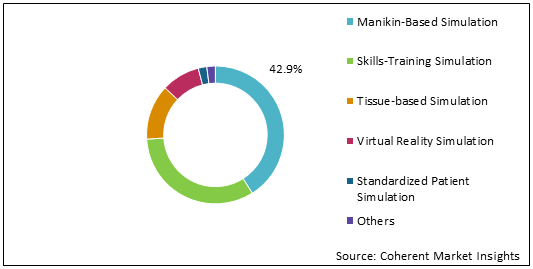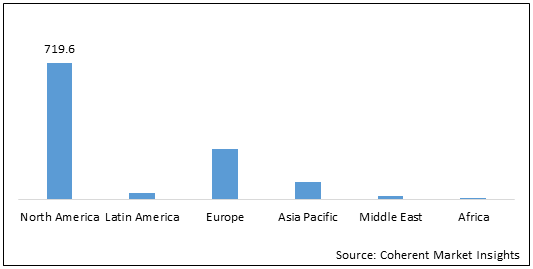Healthcare simulation technology reproduces the clinical situations/environment by creating reel life scenarios of medical conditions, interactive videos in 3D or 4D resolution for a better understanding of operations carried out during healthcare professionals’ training. It is an artificial representation that is used for learning and teaching purpose in medical and research institutes. Globally, the number of medical and research institute is increasing as the need for practices in healthcare services, training programs for skill development. China is one of the leading country for healthcare simulators owing to the adoption of advanced technology. For instance, on October 20, 2019, an article published in PubMed which is a database of abstracts and references in biomedical and life sciences explained about research and development for medical simulation in China states that China produces a large number of high fidelity simulator compartments, which is expected to grow the healthcare simulators market in China.
China produces a large number of high-fidelity simulator chambers.
Global and Chinese Healthcare Simulators Market - Impact of the Coronavirus (COVID-19) Pandemic
The COVID-19 pandemic is expected to drive the growth of the global and Chinese healthcare simulators market over the forecast period. For instance, the World Health Organization’s (WHO) Department of Health Security Preparedness has developed simulation exercises packages that include tabletop exercise and drills also known as vaccine drills, where four factors are mentioned to follow such as set up a vaccination center, developing vaccination site and managing vaccinated recipients. A tabletop simulation exercise includes a PowerPoint presentation to support the facilitation of packages, which include communication and supply chain strategies, regulatory and safety issues, public health and social measures, health facility and infection prevention facility.
Increasing awareness about simulators by the market players is expected to increase the growth of the global and Chinese healthcare simulators market over the forecast period. For instance, Society for Simulation in Healthcare which is global community for enhancing practices in healthcare sector, has celebrated Healthcare Simulation Week 2021, held from September 13, 2021 to September 19, 2021. The motive behind celebrating this week is to raise awareness about clinical professions using simulators training and provide a platform for the global simulation community to come together and represent new researches and inventions among market players.
The global and Chinese healthcare simulators market is estimated to be valued at US$ 1,913.9 Mn in 2021 and is expected to exhibit a CAGR of 14.9 % over the forecast period (2021-2028).
Figure 1: Global and Chinese Healthcare Simulators Market Share (%) Analysis, By Service, 2021

To learn more about this report, Download Free Sample
Key players are engaged in inorganic activities such as collaborations in order to expand research and development activities, which is expected to drive the growth of the global and Chinese healthcare simulators market over the forecast period.
Market players are involved in research and development activities for developing healthcare simulators. This is expected to increase the growth of the global and Chinese healthcare simulators market over the forecast period. For instance, on October 15, 2021, the University of Virginia and the School of Nursing signed a collaboration for efficient use of space and resources in the centralized building for management to match workloads which will reduced the cost of advanced simulators of this co-operation.
Market players are indulged in receiving grants for the healthcare simulators for the training and developments in healthcare services of the global and Chinese healthcare simulators market over the forecast period.
Increasing grants and permissions from the regulatory authorities are expected to drive the growth of the global and Chinese healthcare simulators market over the forecast period. For instance, on September 20, 2021, Certara, which is a provider of drug development software and services based in the U.S., received grant from the U.S. food and drug administration (FDA) for advance virtual Bioequivalence (BE) assessment of generic medicine by using bio simulation. As bioequivalence tests reveal the extent and rate of absorption of the investigational product in comparison to reference drug product, this assessment will help in rapid, safe, and cost-effective development of generic drug product.
Global and Chinese Healthcare Simulators Market Report Coverage
| Report Coverage | Details | ||
|---|---|---|---|
| Base Year: | 2020 | Market Size in 2021: |
US$ 1,913.9 Mn |
| Historical Data for: | 2018 to 2020 | Forecast Period: | 2021 to 2028 |
| Forecast Period 2021 to 2028 CAGR: | 14.9% | 2028 Value Projection: |
US$ 5,073.5 Mn |
| Geographies covered: |
|
||
| Segments covered: |
|
||
| Companies covered: |
Laerdal Medical, 3M, 3D Systems, Simulab Corporation, Simulaids, Inc., Kyoto Kagaku, Mentice, Medaphor, CAE Healthcare, Gaumard Scientific Company, Limbs & Things, BT INC., Trandomed 3D, Fujian Zhongli Co., Tellyes Scientific Co. Ltd, Kavo Dental , Surgical science AB, and Adam Rouilly Ltd |
||
| Growth Drivers: |
|
||
| Restraints & Challenges: |
|
||
Uncover macros and micros vetted on 75+ parameters: Get instant access to report
Global and Chinese Healthcare Simulators Market – Restraints
The growing availability of virtual training and distance learning education is indicating a shift toward less hands-on training practices, which is expected to drive the growth of the global and Chinese healthcare simulator market over the forecast period. For instance, on October 21, 2021, an article published in Research Gate journal explained the application of simulations and improvisation in simulation explains the differences between simulation training and real-life scenarios with patients. According to the article, the treatment and medical decisions rely upon the patient’s condition, while in a virtual training program, the program is designed by healthcare professionals experts based on previous encounters.
The high cost of medical simulators, which is directed for training and education purposes, is expected to hamper the growth of the global and chinese healthcare simulators market over the forecast period. For instance, on September 7, 2021, the researchers at West Virginia University, U.S. explained about next-generation simulations with average expenses for learning platforms such as cadaver-based simulation which is a human dead body used as simulator for training which cost around US$ 3,000- US$ 10,000, and virtual atlas of human anatomy cost ground US$ 100 for personal use, where BodyViz anatomy cost around US$ 6,000- US$ 18,000 and 3D Organon anatomy systems cost around US$ 2,000.
Global and Chinese Healthcare Simulators Market – Regional Analysis
On the basis of region, the global and chinese healthcare simulators market is segmented into North America, Latin America, Europe, Asia Pacific, Middle East, and Africa.
North America healthcare simulators market is expected to hold a dominant position during the forecast period, owing to increasing inorganic activities such as collaborations, partnerships, and agreements among market players. For Instance, on July 6, 2021, CAE Healthcare, a simulation-based education provider based in Canada, announced a simulation research partnership with The Rush center, an educational institute by American college of surgeons (ACS) and society for simulation health (SSH), for clinical skills and simulation. This partnership aims is to provide advanced medical simulation technology to students and improve patient’s safety including research initiatives.
Furthermore, Europe is also estimated to witness a significant growth in the global healthcare simulators market, owing to the increasing research and development activities by the market players and research institutes. For instance, on November 15, 2021, AIBODY, advanced healthcare technology based company based in the U.K., introduced first digital human organism at MEDICA 2021, a medical trade fair for companies to introduce their innovation and advanced technology in the market. AIBODY is a virtual patient software that includes a physiologically highly detailed virtual simulator for medical condition and treatment protocol. This simulator replicates the realistic cardiovascular, pulmonary, and bleeding processes with organ system.
Figure 2: Global and Chinese Healthcare Simulators Market (US$ Mn), by Region, 2021

To learn more about this report, Download Free Sample
Global and Chinese Healthcare Simulators Market – Competitive Landscape
Major players operating in the global and Chinese healthcare simulators market include Laerdal Medical, 3M, 3D Systems, Simulab Corporation, Simulaids Inc., Kyoto Kagaku, Mentice, Medaphor, CAE Healthcare, Gaumard Scientific Company, Limbs & Things, BT INC., Trandomed 3D , Fujian Zhongli Co., Tellyes Scientific Co. Ltd., Kavo Dental , Surgical science AB, and Adam Rouilly Ltd
Share
Share
Missing comfort of reading report in your local language? Find your preferred language :
Transform your Strategy with Exclusive Trending Reports :
Frequently Asked Questions
Select a License Type
Joining thousands of companies around the world committed to making the Excellent Business Solutions.
View All Our Clients